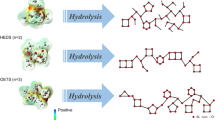Abstract
A number of dendrons of various chain lengths derived from the esters of 3,4,5-tris(tetradecyloxy)benzoic acid were synthesized. These esters were used as building blocks in the design of polyester molecules. Intermediate products, such as branched compounds with variation of functional groups in focal point (aromatic acids and their benzyl esters, aldehydes of different generation) were obtained. The structure and purity of all the compounds were determined by elemental analysis, FT-IR, NMR spectroscopy, mass spectrometry (MALDI-ToF). The phase behavior was investigated by differential scanning calorimetry and confirmed by polarized optical microscopy. Consequently, it was established that the liquid-crystalline properties of this series of dendrons arise from the degree of branching. This behavior can be explained by the formation of hydrogen bonds, as well as microsegregation processes of the links of the macromolecule.

A new series of compounds derived from esters of 3,4,5-tris(tetradecyloxy)benzoic acid were synthesized. It was established that the liquid-crystalline properties of this series of dendrons arise from the degree of branching. This behavior can be explained by the formation of hydrogen bonds as well as processes of microsegregation of the links of the macromolecule.







Similar content being viewed by others
References
Newkome G R, Moorefield C N and Voegtle F 2001 In Dendrimers and dendrons: Concepts, syntheses and applications (Weinheim: Wiley-VCH) p. 636
Smith D K, Hirst A R, Love C S, Hardy J G, Brignell S V and Huang B 2005 Prog. Polym. Sci. 30 220
Bauer S, Fisher H and Ringsdorf H 1993 Angew. Chem.Int. Ed. 32 1589
Pesak D J and Moore J S 1997 Angew. Chem. Int. Ed. 36 1636
Meier H and Lehmann M 1998 Angew. Chem. Int. Ed. 37 643
Cameron J H, Facher A, Lattermann G and Diele S 1997 Adv. Mater. 9 398
Tian Y Q, Kamata K, Yoshita H and Iyoda T 2006 Chem. Eur. J. 12 584
Frauenrath H 2005 Prog. Polym. Sci. 30 325
Turrin C-O, Maraval V, Leclaire J, Dantras E, Lacabanne C, Caminade A-M and Majoral J-P 2003 Tetrahedron 59 3965
Ropponen J, Tamminen J, Lahtinen M, Linnanto J, Rissanen K and Kolehmainen E 2005 Eur. J. Org. Chem. 2005 73
Ropponen J, Tuuttila T, Lahtinen M, Nummelin S and Rissanen K 2004 J. Polym. Sci. Part A. 42 5574
Percec V, Cho W-D, Ungar G and Yeardley D J P 2001 J. Am. Chem. Soc. 123 1302
Percec V, Won B C, Peterca M and Heiney P A 2007 J. Am. Chem. Soc. 129 11265
Percec V, Peterca M, Dulcey A E, Imam M R, Hudson S D, Nummelin S, Adelman P and Heiney P A 2008 J. Am. Chem. Soc. 130 13079
Grebenkin M F and Ivaschenko A V 1989 In Liquid crystalline materials (Moscow: Khimiya) p. 228
Tschierske C 2001 J. Mater. Chem. 11 2647
Pegenau A, Hegmann T, Tschierske C and Diele S 1999 Chem. Eur. J. 5 1643
Chervonova U V, Gruzdev M S, Kolker A M, Manin N G and Domracheva N E 2010 Rus. J. Gen. Chem. 80 1954
Chervonova U V, Gruzdev M S and Kolker A M 2011 Rus. J. Gen. Chem. 81 1853
Vorobeva V E, Domracheva N E, Pyataev A V, Gruzdev M S and Chervonova U V 2015 Low Tem. Phys. 41 15
Chervonova U V, Gruzdev M S and Kolker A M 2011 Rus. J. Gen. Chem. 81 2288
Schaz A, Valaityte E and Lattermann G 2005 Liq. Cryst. 32 513
Tully D C, Wilder K, Fréchet J M J, Trimble A R and Quate C F 1999 Adv. Mater. 11 314
Saudan C, Balzani V, Gorka M, Lee S-K, Maestri M, Vicinelli V and Vögtle F 2003 J. Am. Chem. Soc. 125 4424
Denieul M P, Laursen B, Hazell R and Skrydstrup T 2000 J. Org. Chem. 65 6052
Shreenivasa Murthy H N and Sadashiva B K 2004 Liq. Cryst. 31 1347
Seeboth Arno, Lotzsch Detlef, Ruhmann Ralf and Muehling Olaf 2014 Chem. Rev. 114 3037
Ishihara S, Furuki Y and Takeoka S 2008 Polym. Adv. Technol. 19 1097
Beltrán E., Cavero E., Barberá J, Serrano J L, Elduque A and Giménez R 2009 Chem. Eur. J. 15 9017
Acknowledgements
This work was supported by the grant of Russian Foundation for Basic Research No. 14-03-31280-mol_a and the grant of the President of the Russian Federation (No. MK-70.2014.3). Dr. Akopova O.B. is thankful for the grant of Ministry of education and science RF (No. 4.106.2014K). EA, NMR, FT-IR spectroscopy and DSC analysis were carried out by the equipments of Interlaboratory scientific center «Verhnevolzhskij region center of physicochemical researching». The authors would like to thank Dr. Simon Dalgleish (Nagoya University) for useful discussion.
Author information
Authors and Affiliations
Corresponding author
Additional information
Supplementary information (SI)
All additional information pertaining to characterization of the compounds using NMR spectra, FT-IR spectra and mass-spectra are given in the supporting information. The electronic supporting information can be seen in www.ias.ac.in/chemsci.
Electronic supplementary material
Below is the link to the electronic supplementary material.
Rights and permissions
About this article
Cite this article
GRUZDEV, M., CHERVONOVA, U., AKOPOVA, O. et al. Synthesis and phase behavior of dendrons derived from 3,4,5-tris(tetradecyloxy)benzoic acid with different functional groups in focal point. J Chem Sci 127, 1801–1810 (2015). https://doi.org/10.1007/s12039-015-0945-4
Received:
Revised:
Accepted:
Published:
Issue Date:
DOI: https://doi.org/10.1007/s12039-015-0945-4




